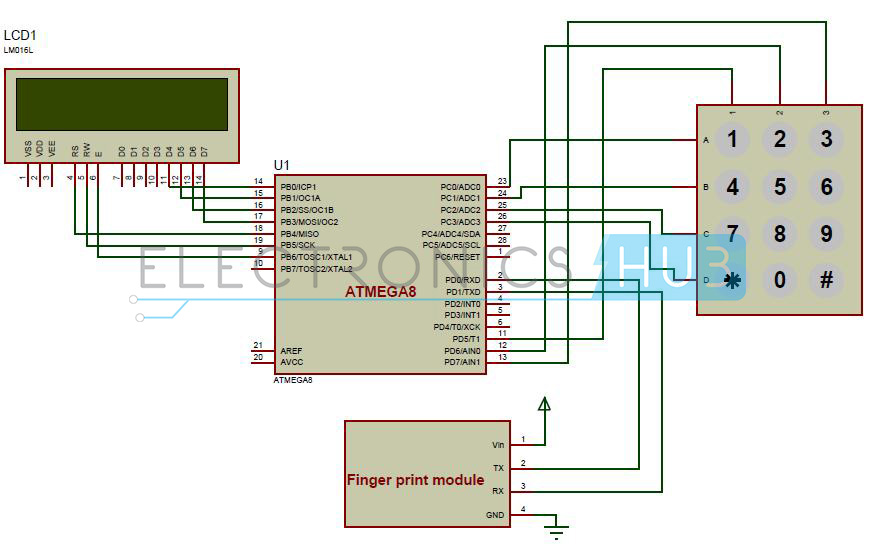Biometric Attendance System Circuit Principle:
The main aim of this circuit is to take the attendance and display when requested. Finger print identification is based on the fact that no two persons will have the same finger print in this world. This is because of the peculiar genetic code of DNA in each person. Finger print module differentiates between two fingers based on the ridges and valleys on finger print. When the finger print is given it stores the points where there are changes in the direction of ridges and valleys using some algorithms. Inside the finger print module a DSP processor is present to implement and analyze the algorithm. Main heart of the circuit is finger print module. This sends commands to the controller when ever finger print is matched. Microcontroller receives these commands from the finger print module and uses the internal EEPROM to store the attendance. Keypad is used to send the requests to the controller either enroll the new one or to save the attendance or to exit.LCD display displays the messages related to the commands received.
Biometric Attendance System Circuit Diagram:
Circuit Components:
AVR microcontroller development board. Fingerprint module R305. Keypad (43). Atmega8 microcontroller RS232 Serial cable. DC Battery or Adaptor (12V, 1Amp). 162 Alpha Numeric LCD. Single pi connecting wires.
Biometric Attendance System Circuit Design:
Here, we used an ATmega8 microcontroller which is an AVR family microcontroller. It is 8 bit microcontroller and has 23 programmable input and output pins. It has 8 KB of flash memory, 512 bytes of EEPROM, 1KB of SRAM. Biometric module used here is R305 series finger print module. It supports USART communication protocol. Here, USART protocol is used for communicating with the micro controller. USART is universal synchronous and asynchronous receiver and transmitter. This module has four pins out 1) Transmit, 2) Receive, 3) Vin, 4) GND. Transmit pin is connected to the receive pin of the microcontroller. Receive pin should be connected to the transmit pin of the microcontroller. Vin is applied with a voltage of 5V and GND is connected to ground. Data can be transmitted or received using serial communication. Finger print processing involves two steps.1) finger enrollment and 2) finger matching. Initially, to enroll the finger user must give his finger print twice to the module. Module checks these two images and generates a template image and stores it. In the second step of finger matching, for 1:1 matching input finger print is matched with the template image generated and it generates an acknowledgement. For 1: N matching input is matched with the images in the library. It gives the matched image, a page id of the matched image is generated. Keypad used in this project is 4*3 keypad i.e. it has four rows and three columns. Columns of the keypad are connected to the PORT D pins of the microcontroller. PD5 to PD7 pins are connected to the three columns of the keypad. Rows are connected to the PORT C of the microcontroller. PC0 to PC3 pins are connected to the rows of the keypad. To give attendance, press 1 from the keypad and to enroll press 2 from the keypad, to clear all the data press 3 from the keypad. Liquid crystal display is used for displaying the messages. This is interfaced to PORTB of the micro controller. LCD in 4bit mode is connected to the micro controller. D4-D7 pins are connected to the PB0-PB3 pins of the microcontroller. RS pin is connected to the PB4, RW pin is connected to the PB5 and Enable pin is connected to the PB6 pin.
Working of Fingerprint Based Attendance System Circuit:
Biometric Attendance System Circuit Applications:
There is a chance of misusing the technology by placing a fake finger print. Modules are sensitive and they need to be handled carefully.
Kindly send me the code and circuit diagram to my mail @ gourabagrawal@gmail.com. Thanks in Advance. thanks Comment * Name * Email * Website
Δ






![]()